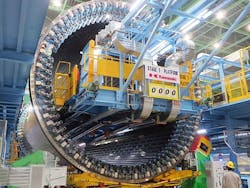Aerospace supply chain under cost pressure as OEMs seek technically adequate, best cost solutions
The commercial aerospace sector holds great opportunity, while the defense side is winding down, recognizes Tim Shillair, new product introduction supply chain and operations manager (NPI SCM/Ops manager) at Crane Aerospace & Electronics in Lynnwood, Washington. Virtually all market analysts tend to favor this view, as do the latest market figures and forecasts.
| News from the I-90 Aerospace Corridor Engineers and executives committed to creating a better aerospace future assembled in Coeur d’Alene, Idaho, at the I-90 Corridor Aerospace Expo, hosted by the Idaho Aerospace Alliance, Inland Northwest Aerospace Consortium (INWAC), and American Manufacturer Network. The aerospace community in Spokane – a major city and home to Fairchild Air Force Base in the I-90 corridor – generates roughly $680 million in revenue and employs approximately 12,000 people annually, analysts report. Industry analysts also predict that aerospace manufacturing will grow by 20 percent over the next decade. The information in this article was presented at the I-90 Corridor Aerospace Expo. For more, visit: http://www.intelligent-aerospace.com/_search?q=I-90+corridor&x=0&y=0 |
Crane, with headquarters in Stamford, Connecticut, boasts 11,500 employees in 150 locations, 26 years in operation, and $2.7 billion in sales. The Crane Aerospace & Electronics division in Lynnwood, Wash., operates 10 aerospace manufacturing locations and achieves $691 million in sales annually -- 70 percent of which hails from the commercial aerospace market sector.
Crane technology can be found on most commercial aircraft, Shillair says. The company’s portfolio of six integrated solutions includes:
- Antiskid braking for aerospace landing gear (electronic systems)
- High-reliability sensing for critical systems
- Application-critical fluid components
- Power electronics
- Actuation under cabin seating (“flying on every large commercial aircraft today,” Shillair notes)
- Microwave components and systems, such as for radar, satellite, and other space applications, including a space fence project for tracking space debris with Lockheed Martin
Shillair outlined several interested aerospace trends he is seeing and predicts will continue; they are:
“Demand for travel is driving growth in commercial aerospace. Along with this growth is an increasing drive for efficiency,” Shillair says.
The aerospace sector employed 1.2 million directly and 3.2 million indirectly last year, and 2016 is expected to see another 40,000 jobs added in the U.S.
2015 was the most profitable year in history for airlines: 75 percent year-over-year increase in profit, to the tune of $30 billion.
Airbus has been aggressive in pursuing new supplies and systems, resulting in both challenges and opportunities. The Toulouse, France-based airframe manufacturer is closing in on Boeing’s cost averages, Shillair admits. In turn, cost-down initiatives are putting pressure on the supply chain to deliver advanced, reliable, safety-critical components and systems at low cost. Even so, opportunities lie in airframe manufacturers’ record, 10-year backlogs, even in the face of increasing build rates – including ramping up production rates by nearly 200 percent to roughly 1500 aircraft per year.
The aerospace supply chain is experiencing cost pressure from original equipment manufacturers (OEMs). Tier 1 and Tier 2 suppliers are increasingly choosing the option that is “technically adequate, best cost,” Shillair observes.
OEMs are also encroaching into the spares market, selling products at cost to airframers and making up some [revenue] by selling aftermarket spares – but that market is eroding, Shillair says.
Top-tier aerospace organizations are actively seeking a technical advantage, but are no longer willing to pay more for increased performance, Shillair adds.
Crane is designing more molded parts into systems. It provides weight and cost savings, but development lead times are longer; dimensional tolerances are harder to hit and control. 3D printing, also commonly called additive manufacturing, is right on the horizon, Shillair predicts.
“To win the price battle, we must work with our suppliers to find innovative ways to reduce real cost, not just negotiate price. The objective is to create high-reliability, simple designs that are easy to manufacture at a high yield,” Shillair concludes.
Search the Aerospace & Defense Buyer's Guide
You might also like:
Subscribe today to receive all the latest aerospace technology and engineering news, delivered directly to your e-mail inbox twice a week (Tuesdays and Thursdays). Sign upfor your free subscription to the Intelligent Inbox e-newsletter at http://www.intelligent-aerospace.com/subscribe.html.
Connect with Intelligent Aerospace on social media: Twitter (@IntelligentAero), LinkedIn,Google+, and Instagram.
Intelligent Aerospace
Global Aerospace Technology NetworkIntelligent Aerospace, the global aerospace technology network, reports on the latest tools, technologies, and trends of vital importance to aerospace professionals involved in air traffic control, airport operations, satellites and space, and commercial and military avionics on fixed-wing, rotor-wing, and unmanned aircraft throughout the world.


